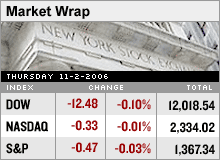Dow loss streak longest in over a yearMajor gauges erase most of the session's declines by the close, but worries about the economy remain; oil prices slip.NEW YORK (CNNMoney.com) -- Stocks cut losses by the close Thursday, fighting back at the end of a choppy session marred by a trio of weak morning economic reports and some jitters about Friday's big employment release. The Dow Jones industrial average (down 12.48 to 12,018.54, Charts) lost 0.1 percent, falling for the fifth session in a row. It was the longest down streak since June 2005.
The broader S&P 500 (down 0.47 to 1,367.34, Charts) index and the tech-fueled Nasdaq composite (down 0.33 to 2,334.02, Charts) both ended just below the unchanged line. Stocks have been under pressure lately, following a strong rally in the third quarter and through most of October. The recent declines have been sparked by a series of weak reads on the economy, which have raised worries about the speed of the current slowdown. The same trend seemed to emerge Thursday, following a sluggish reading on factory orders, a jump in a key inflation reading and some disappointing retail sales. But the tone of the market improved as the session wore on, suggesting that the selloff may be petering out. "We've had a strong run over the last several months and the odds certainly favor a short-term pullback," said Michael Sheldon, chief market strategist at Spencer Clarke. "But the bulls certainly aren't giving up without a fight. I think we're seeing that today." The focus for many investors has shifted recently from third-quarter earnings to the economic news, particularly as it's been weaker lately. In the short run, that means Friday's October employment report will be the next potential market catalyst. Employers are expected to have added 125,000 jobs to their payrolls in October, according to a consensus of economists surveyed by Briefing.com. That would be up from the surprisingly weak 51,000 added in September. The unemployment rate, generated by a separate survey, is expected to hold steady at 4.6 percent. Average hourly earnings, the report's inflation component, is expected to have risen 0.3 percent after rising 0.2 percent. "As long as the payrolls number tomorrow isn't a big jolt, as long as its relatively in line, the market should be fine with it," said Joseph Saluzzi, co-head of equity trading at Themis Trading. After the close of trade, Qualcomm (up $0.63 to $36.36, Charts) reported fiscal fourth-quarter earnings and sales that rose from a year ago and topped estimates. The company also issued a fiscal first-quarter earnings forecasts in a range that sets the midpoint below analysts' average forecast. Shares were barely higher in extended-hours trading. Also after the close, CA (up $0.58 to $25.28, Charts) reported quarterly earnings that beat estimates, but also warned that full-year earnings would miss forecasts. Shares slumped about 5 percent in extended-hours trade. Shares of CA, a software maker, had risen more than 2 percent during the regular session on news that Sanjay Kumar, the former CEO, was sentenced to 12 years in prison Thursday for his part in an accounting scandal at the company. A preliminary read on third-quarter productivity, released Thursday morning, came in unchanged, versus forecasts for a rise of 1.1 percent. Unit labor costs, the report's inflation component, jumped 3.8 percent, topping forecasts and reviving concerns about wage inflation. Another report showed September factory orders rose 2.1 percent, missing expectations for a rise of 3.6 percent. Orders fell 0.3 percent in the previous month. A separate report showed a bigger-than-expected jump in weekly jobless claims. However, it was overshadowed by anticipation about Friday's monthly employment report. Investors also took in afternoon comments from Dallas Federal Bank President Richard Fisher, who is not a voting member of the Federal Reserve's policy-setting committee. Fisher said recent inflation readings have been encouraging, but pricing pressure is still too aggressive. Stock movers Wall Street digested a wave of mostly sluggish October sales from big retailers. Among the standouts, Wal-Mart Stores (down $0.56 to $48.29, Charts) said sales at stores open at least a year, known as same-store sales, rose just 0.5 percent in the month. That was lower than the company's recently reduced forecast for growth of 1 percent. Shares fell 1.2 percent. Rival Target (down $0.74 to $56.96, Charts) posted a 3.9 percent rise in same-store sales, missing forecasts and sending its stock down about 1.3 percent. Chico's FAS (down $1.84 to $21.41, Charts) reported a 4.1 percent drop in sales and cut its earnings forecast to a range that's below analysts' forecasts. Shares of the women's clothing retailer fell nearly 8 percent in active New York Stock Exchange trading. Gap (down $1.14 to $19.50, Charts) said sales fell 7 percent, versus analysts' expectations for a decline of 2.4 percent. Following the news, Citigroup (Charts) downgraded the stock to "hold" from "buy." Shares fell 5.5 percent. Among other movers, Dell (up $0.78 to $24.80, Charts) jumped 3.3 percent after Goldman Sachs upgraded the stock to "neutral" from "sell," according to a Reuters report. Market breadth was negative. On the New York Stock Exchange, losers topped winners by almost nine to seven on volume of 1.67 billion shares. On the Nasdaq, decliners beat advancers three to two on volume of 1.93 billion shares. U.S. light crude oil for December delivery fell 83 cents to settle at $57.88 a barrel on the New York Mercantile Exchange. Treasury prices slumped on the economic news, raising the yield on the 10-year note to 4.60 percent from 4.56 percent late Wednesday. Bond prices and yields move in opposite directions. In currency trading, the dollar fell versus the euro and was little changed against the yen. COMEX gold for December delivery added $8.40 to $627.70 an ounce. |
|




